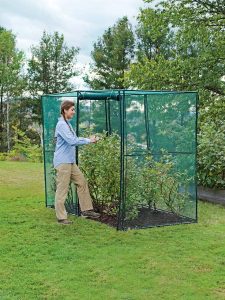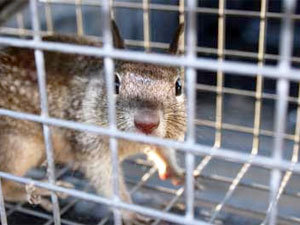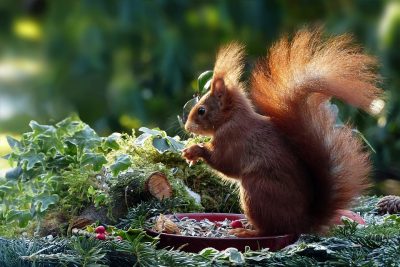Squirrels are persistent creatures when it comes to accessing bird feeders. Their acrobatic abilities and determination can quickly empty feeders meant for your feathered visitors. A properly designed squirrel-proof bird feeder can help keep these agile rodents at bay while still providing nourishment for the birds you want to attract. This guide covers everything you need to know about selecting, installing, and maintaining effective squirrel-proof bird feeders.
Quick Picks: Best Squirrel-Proof Bird Feeders

Editor’s Choice
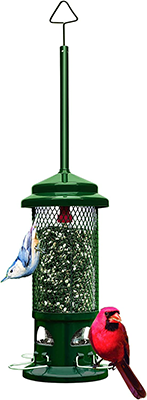
People’s Choice
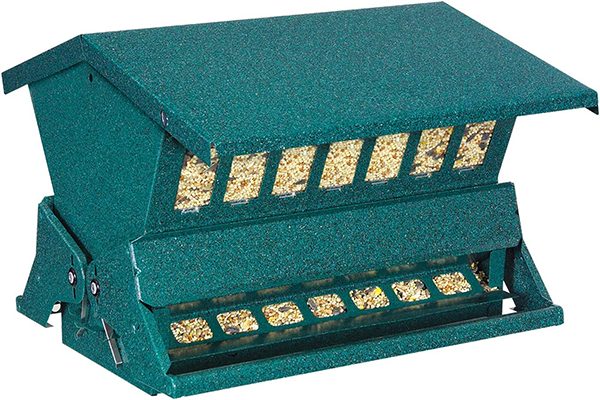
High Capacity

Best for Suet
Why Squirrels Target Bird Feeders

Squirrels are opportunistic feeders with a hearty appetite for the nuts and seeds commonly found in bird feeders. Their remarkable agility and problem-solving abilities make them formidable adversaries for anyone trying to maintain a bird-only feeding station.
Food Motivation: Bird seed provides squirrels with a high-calorie, readily available food source that requires less effort than foraging.
Territory Establishment: If your yard becomes a reliable food source, squirrels may build nests in nearby trees or even attempt to inhabit your attic.
Problem-Solving Skills: Squirrels can remember solutions to obstacles and will persistently test different approaches to access food.
Top Squirrel-Proof Bird Feeder Options
When selecting a squirrel-proof bird feeder, consider factors like durability, capacity, and the specific mechanism used to deter squirrels. Here are our top picks that have proven effective at keeping squirrels at bay while remaining bird-friendly.
Our top recommendation is the Droll Yankees Flipper. This innovative feeder features a sturdy polycarbonate tube that’s 4-3/4 inches in diameter and 21 inches long, providing ample capacity (up to five pounds of seed) and minimizing refill frequency.
The Droll Yankees Flipper utilizes a battery-powered motor connected to a weight-activated perch ring. While birds can land and feed normally, squirrels trigger the motor with their weight, causing the perch to spin. This safely tosses the squirrel off the feeder, providing both effective deterrence and entertaining backyard drama.
- Motorized defense mechanism that activates only when squirrels (not birds) land on the perch
- Rechargeable battery system ensures continuous protection without constant battery replacements
- Four separate feeding ports allow multiple birds to feed simultaneously
- Large seed capacity means less frequent refilling
The Squirrel Buster Standard is an excellent choice for those seeking a more compact feeder. Holding up to 1.3 pounds of bird seed, this feeder features four metal perches and a wire shroud that provides additional landing spots for clinging birds.
This feeder employs a weight-adjustable spring mechanism. When a squirrel climbs onto the feeder, its weight forces the shroud down, closing access to the feeding ports. The system can be calibrated to allow larger birds to feed while still blocking squirrels.
For high bird traffic areas, the H-F Green Absolute II is unmatched. This rectangular feeder features an impressive 14 separate feeding stations and can hold up to 12 pounds of seed, making it ideal for yards with numerous avian visitors.
This feeder uses weight-adjustable perches that can be calibrated to support birds of various sizes while triggering a closing mechanism when heavier squirrels attempt to access the seed. The adjustable settings allow you to customize the feeder based on the bird species you wish to attract.
The More Birds Squirrel-X is designed specifically for suet cakes rather than loose seed. This feeder can hold two suet cakes simultaneously and features a metal roof to keep the food dry during inclement weather.
Unlike other feeders on our list, this model relies on a simple but effective cage design. The 360-degree double metal cage has openings sized perfectly for birds to access the suet while preventing squirrels from reaching in with their paws or heads.
Key Features to Look for in Squirrel-Proof Bird Feeders
When shopping for a squirrel-proof bird feeder, certain features can make the difference between success and frustration. Here are the most important factors to consider:
| Feature | Description | Effectiveness |
|---|---|---|
| Weight-Sensitive Mechanisms | Triggers when squirrel weight is detected, either closing ports or activating a deterrent | High |
| Cage Protection | Surrounds feeding ports with openings sized for birds but too small for squirrels | High |
| Baffle Systems | Dome or cylinder-shaped barriers that prevent climbing access | Medium-High |
| Spinning/Moving Components | Parts that move, spin, or tilt when squirrels attempt to land | High |
| Durable Materials | Metal or chew-resistant plastic components that resist squirrel damage | Medium |
Durability
Squirrels have powerful teeth that continuously grow, requiring regular filing down through gnawing. Select feeders made from durable materials such as powder-coated metals or UV-resistant resins that can withstand chewing attempts. Wooden feeders, while aesthetically pleasing, are more vulnerable to damage.
Strategic Mounting Options
Where and how you mount your feeder significantly impacts its squirrel resistance:
The “5-9 Rule” is essential: Mount feeders at least 5 feet high and 9 feet away from any jumping point like trees, roofs, or fences.
Pole-mounted feeders offer good protection when properly installed with additional barriers. Hanging feeders require more careful positioning to prevent squirrels from accessing them from above or by jumping.
Accessibility Reduction Features
Various mechanisms can limit squirrel access while still allowing birds to feed comfortably:
Caged Feeders
Wire cages surrounding feeders create a barrier that allows smaller birds to reach the seed through the gaps while keeping squirrels out. These work exceptionally well for attracting songbirds but may exclude larger desirable birds like cardinals or blue jays.
Mechanical Mechanisms
Battery-operated or weight-triggered mechanical devices respond when a squirrel’s weight is detected. These can include spinning perches, closing ports, or tilting feeding platforms that make it impossible for squirrels to maintain their grip.
Baffle Systems
Baffles are physical barriers typically shaped like domes or cylinders that prevent squirrels from climbing down to hanging feeders or up to pole-mounted ones. They can be purchased separately and added to existing feeders.
DIY Squirrel-Proofing for Existing Bird Feeders
If you already have bird feeders that aren’t squirrel-proof, you don’t necessarily need to replace them. Try these cost-effective modifications to improve their squirrel resistance:
1. Strategic Placement
The simplest approach is to relocate your feeder following the 5-9 rule: at least 5 feet off the ground and 9 feet away from any jumping point. This alone can significantly reduce squirrel access.
Squirrels can leap horizontally up to 9 feet and drop down from heights of 10+ feet. Consider all possible access routes when placing your feeder.
2. Add a DIY Baffle
Create a baffle using household items:
- For pole-mounted feeders: Use a length of smooth 4-inch PVC pipe or a plastic bowl with the bottom cut out
- For hanging feeders: An inverted plastic bowl or plant pot with a hole drilled through the center works well
3. Try the Slinky Method
A simple and surprisingly effective option for pole-mounted feeders is to attach a metal Slinky toy to the pole. Secure one end of the Slinky near the top of the pole and let it hang down, creating an obstacle that collapses under a squirrel’s weight.
To install a Slinky baffle, stretch the Slinky slightly and secure it to the pole with zip ties or wire just below the feeder. Allow it to hang freely down the pole.
4. Create a Barrier with Plastic Bottles
For wire-hung feeders, thread empty plastic bottles onto the wire on either side of the feeder. The bottles spin when squirrels try to cross them, causing them to lose their grip and fall.
5. Upgrade Your Pole Material
If your feeder is mounted on a wooden post that squirrels can easily climb, consider switching to a smooth metal or PVC pole. The slick surface provides less traction for climbing squirrels.
6. Install a Spinning Hook
Replace standard hooks with spinning or swiveling hooks designed for hanging plants or wind chimes. When squirrels try to climb down to the feeder, the hook rotates, making it difficult for them to maintain their grip.
Additional Deterrents for Persistent Squirrels
Sometimes even the best squirrel-proof feeders benefit from additional deterrents, especially if you’re dealing with particularly determined squirrels:
Spice Up Your Seed
Birds lack the receptors that detect capsaicin (the compound that makes peppers hot), while mammals like squirrels find it intensely unpleasant. Adding cayenne pepper to your bird seed creates a natural deterrent:
Spicy Seed Mix Recipe
- 3 tablespoons cayenne pepper flakes or powder per pound of bird seed
- Mix thoroughly in a sealed container
- Use moderately – very hot mixtures might irritate birds’ eyes
Commercial hot pepper suet cakes and treated seeds are also available if you prefer not to mix your own.
Choose Squirrel-Resistant Seeds
Some seed types are less appealing to squirrels but still attract a variety of birds:
- Safflower seeds – Most squirrels dislike them, but cardinal, chickadees, and finches love them
- Nyjer (thistle) seeds – Too small for squirrels to bother with, but goldfinches and other small birds adore them
- White proso millet – Less appealing to squirrels but attracts many ground-feeding birds
Create a Seed Catch System
Birds often kick seeds out of feeders while feeding, creating ground opportunities for squirrels. Place a wire-covered bucket or tray beneath your feeder to catch fallen seed and prevent ground feeding.
Maintain a Tidy Yard
Reducing other attractants in your yard can help discourage squirrels from establishing territory near your feeders:
- Promptly remove fallen fruits, nuts, and berries
- Keep pet food indoors or pick it up after feeding
- Secure trash cans with wildlife-resistant lids
- Eliminate standing water sources
Try Natural Repellents
Some scents are unappealing to squirrels but don’t bother birds:
- Hang bars of Irish Spring soap near feeders (place in mesh bags or socks)
- Apply mint-based repellents to poles (not to feeding areas)
- Use ultrasonic repellent devices designed for squirrels
Offer a Decoy Feeding Station
Sometimes the best strategy is compromise. Setting up a separate feeding station specifically for squirrels can reduce their motivation to raid your bird feeders. Place it far from your bird feeding area and stock it with inexpensive corn cobs or peanuts.
Never use sticky substances, petroleum jelly, or oils on poles or feeders. These can coat birds’ feathers, preventing flight and insulation, potentially causing death. Also avoid poisons, which pose serious risks to wildlife, pets, and children.
Frequently Asked Questions
Will squirrel-proof feeders keep away other animals like raccoons?
Most squirrel-proof feeders will deter raccoons to some degree, especially weight-activated models. However, raccoons are stronger and more dexterous than squirrels, so they may overcome certain mechanisms. For raccoon problems, consider bringing feeders in at night when raccoons are most active.
Can larger birds like cardinals use caged feeders?
It depends on the cage spacing. Many caged feeders are designed with openings large enough for cardinals but too small for squirrels. Look for feeders specifically labeled as suitable for larger songbirds, or choose a weight-activated feeder instead of a caged model.
How often do I need to replace cayenne pepper in my seed mix?
The cayenne pepper should be refreshed every time you refill the feeder, as it can lose potency when exposed to weather. For best results, mix the cayenne with the seed just before filling your feeder rather than treating your entire seed supply at once.
Are there any bird species that are also deterred by squirrel-proof feeders?
Weight-activated feeders may exclude larger birds like jays, doves, and woodpeckers. Caged feeders can keep out larger birds depending on the size of the openings. Consider having multiple feeder types to accommodate different bird species.
Do I need to use multiple deterrents, or is one enough?
For most situations, a quality squirrel-proof feeder properly installed will be sufficient. However, particularly persistent squirrels or high squirrel populations may require a combination approach using multiple deterrents for best results.
Conclusion
Keeping squirrels out of your bird feeders requires a combination of the right equipment, strategic placement, and sometimes additional deterrents. By implementing the techniques in this guide, you can significantly reduce squirrel interference while creating a welcoming environment for the birds you want to attract.
The most effective approach often involves:
- Choosing a quality squirrel-proof feeder with mechanical or physical barriers
- Placing feeders following the 5-9 rule (5 feet high, 9 feet from jumping points)
- Adding baffles for additional protection
- Using squirrel-resistant seed types or adding cayenne pepper
With persistence and the right setup, you can enjoy watching birds feed without the constant frustration of squirrel invasions.

